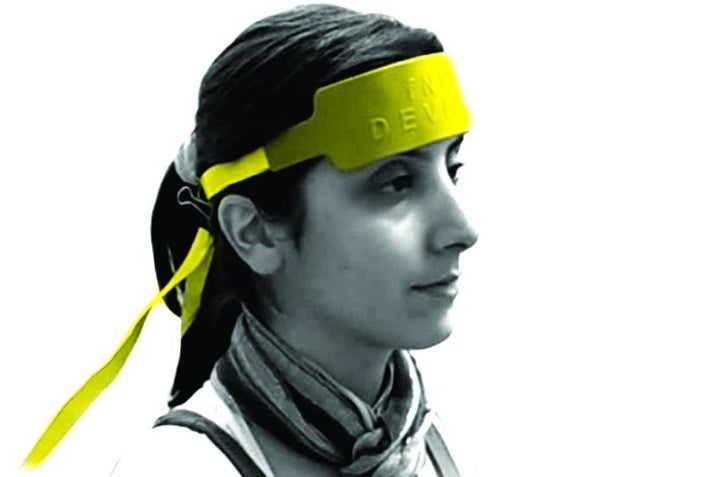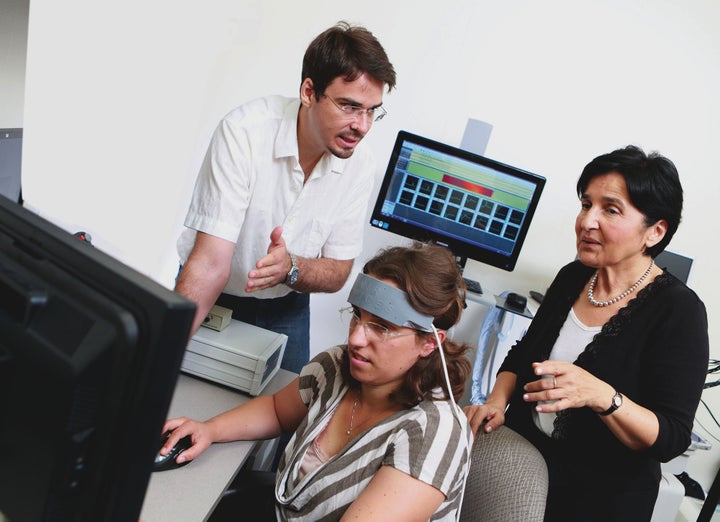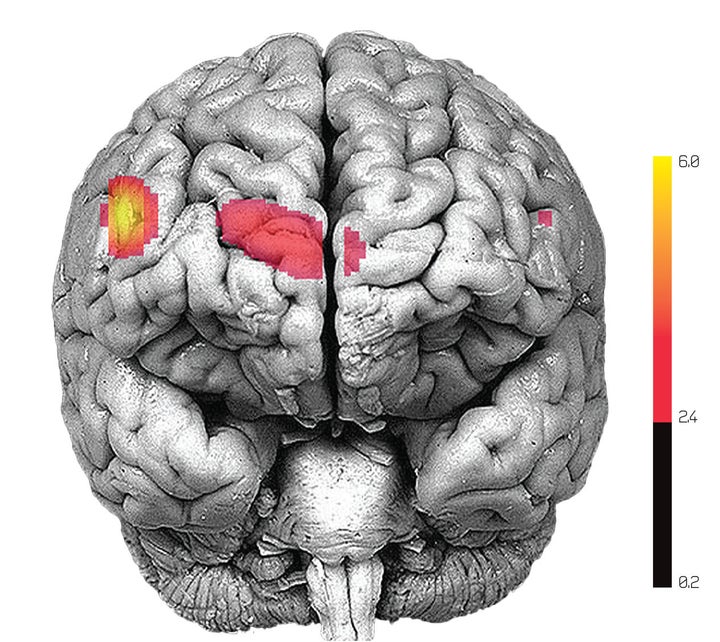Your doctor just diagnosed you with Type 2 diabetes. You’re going to need to change your diet. Something is happening to your pancreas. You need to start paying more attention to your blood pressure. You’ve been told all this but as you leave the doctor’s office, you cannot remember if she said insulin is a prescription you need to fill or a type of blood cell you have too many of. Your head is spinning.
Sometimes you totally connect with people. Other times you don’t.
Now a group of psychologists and biomedical engineers have come up with a new tool they say has the potential to help improve communication in all sorts of real-life scenarios ― from an awkward chat with a friend to doctor-patient conversations to teachers explaining difficult lessons to students.
They’ve designed a headband that measures brain activity, revealing how much a person’s brain is syncing up with someone else’s (and thus, how well two people are communicating).
“When we tell a story, we are actually changing listeners’ brain activity and making it work (in part) similar to our own for a brief period,” Hasan Ayaz, a leading member of the team that developed the new headband, told The Huffington Post.
“Our brains align when there’s information exchanged,” said Ayaz, who is an associate research professor in the School of Biomedical Engineering, Science and Health Systems at Drexel University. “They work in harmony.”
And the new headband can measure whether or not that’s happening, he explained.

Psychologists call this phenomenon of brain activity syncing up when we understand someone else “brain coupling.” It happens when a teacher is explaining Einstein’s theory of relativity and her students get it ― and when a comedian launches into a monologue and has the audience in stitches.
Previous studies using MRI scans have proven that this phenomenon actually happens ― that when two people are “on the same page” the same parts of their brain are active at the same time.
While MRIs prove useful in understanding what’s going on in the brain, the machines ― which tend to be noisy and require participants to be completely still ― aren’t great for measuring real-world interactions, Ayaz explained.
The new headband that Ayaz and his colleagues developed is small and virtually silent ― and could be engineered to be wireless. That means it could essentially be used anywhere to measure how well people are communicating and study ways of improving it.
“Our brains align when there's information exchanged. ... They work in harmony.”
- Hasan Ayaz, leading member of the headband design team
Ayaz and his colleagues are excited because new data they recently published in the journal Scientific Reports showed that the headband worked and effectively captured when activity in two people’s brains was in sync.
Though they’ll require more testing and streamlining, there’s potential to learn about ways of improving teacher-student interactions in classroom settings, doctor-patient communication in clinical settings and more, he said.
Political scientists say that better understanding this phenomenon of “brain coupling” could help make politicians’ interactions more effective, too.
“The innate ability to mirror or simulate another person’s intentions helps to explain why diplomats and leaders put so much faith in the productivity of face-to-face meetings,” said Marcus Holmes, an assistant professor of government at the College of William & Mary, in an article published in the journal International Organization in 2013.
“The shared neural connection, while not fail proof, allows individuals to better understand what the other intends to do, how they intend to act, and whether they are being truthful with respect to their intentions under certain conditions.”
The headband reveals when two brains are in sync
For the new study, Ayaz and his colleagues designed an experiment with one native English speaker and two native Turkish speakers. The researchers recorded all three people individually telling an unrehearsed story in their native language about something that had previously happened to them and used the headband to measure brain activity.
Another group of 15 English speakers each listened to the three stories that had been recorded, as well as a fourth story (in English) from a talk show, all while wearing the headband.

As the researchers predicted (based on previous research finding that people’s brains sync up when they understand each other), the listeners’ brain activity matched the activity of the English-speaking storyteller when the listeners heard the story in English, but did not match the brain activity of the Turkish-speaking storytellers when they listened to the stories in Turkish (since none of the listeners spoke Turkish and did not understand the stories told in Turkish).
“We were able to capture this [brain] synchronization with wearable [functional near-infrared spectroscopy] sensors ― in natural settings, during face-to-face communication,” Ayaz said.
The headband uses infrared (nearly visible, red light) to actually measure the color of the blood in your brain, Ayaz explained. When specific areas of the brain are more active, they consume more oxygen. And when your blood is exposed to oxygen it appears to be red. The sensors in the headband by measuring the color of blood in your brain are thus able to measure activity level.

Other research from Ayaz and his colleagues has shown the headbands can accurately measure brain activity outside the lab as well, including when people were walking outside.
“There’s a lot of research and development to do,” Ayaz noted.
Knowing that brain coupling happens has already allowed psychologists to better understand how people communicate, said Frank Pollick, a University of Glasgow psychology professor who has also studied brain coupling but was not involved in this research. And better understanding what’s going on in the brain opens even more doors for learning about understanding different types of communications, he said.
“Compared to MRIs, the headband approach ― while less powerful in the amount of information it provides ― is much less invasive and really does open the possibility that we can study these processes in natural settings,” Pollick said.
This reporting is brought to you by HuffPost’s health and science platform, The Scope. Like us on Facebook and Twitter and tell us your story: scopestories@huffingtonpost.com.
Sarah DiGiulio is The Huffington Post’s sleep reporter. You can contact her at sarah.digiulio@huffingtonpost.com.
